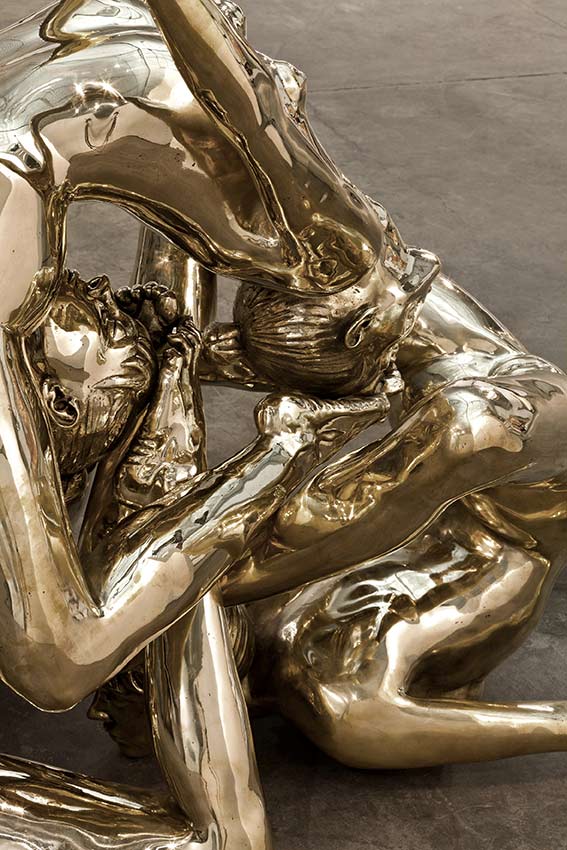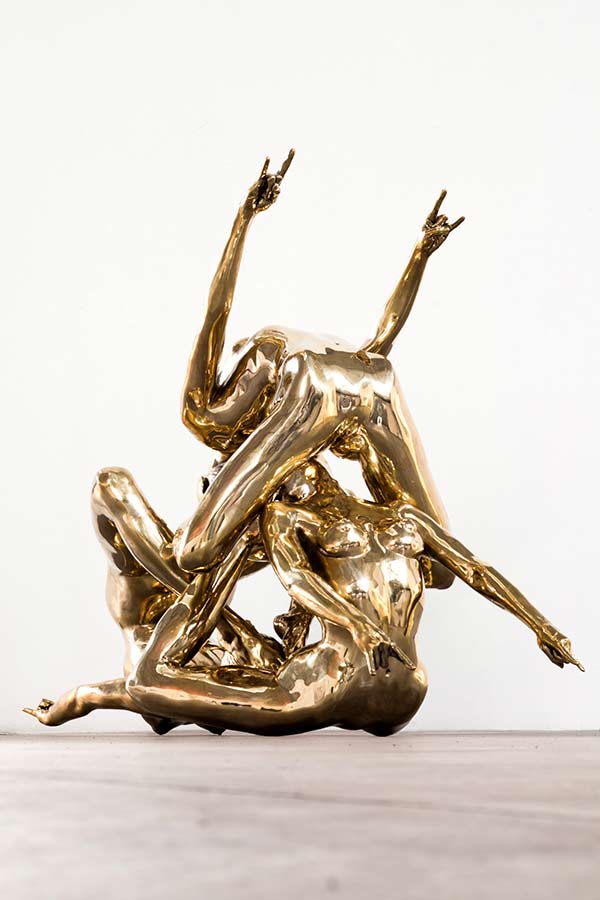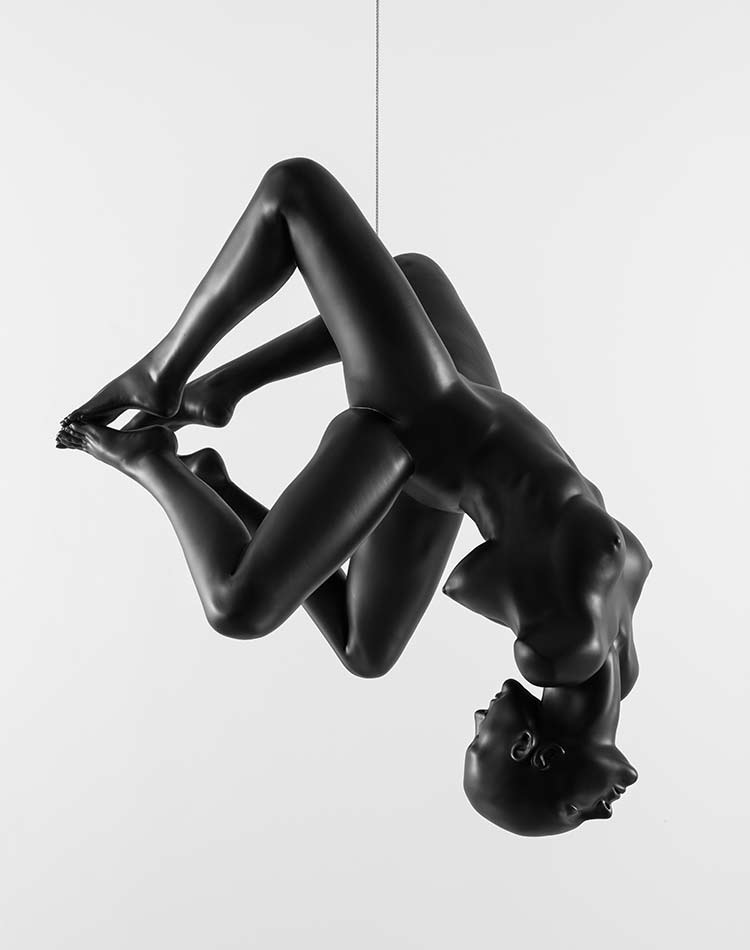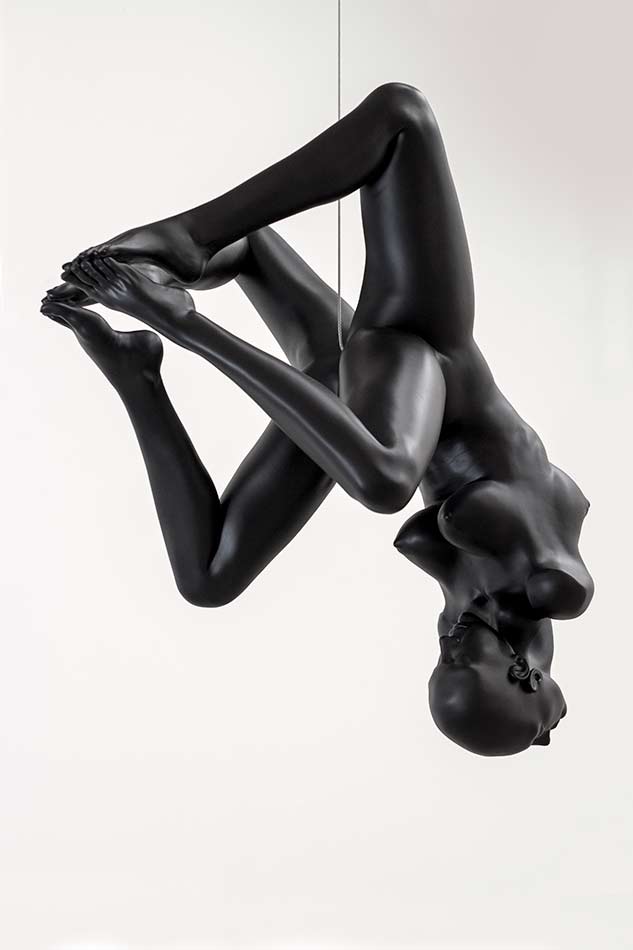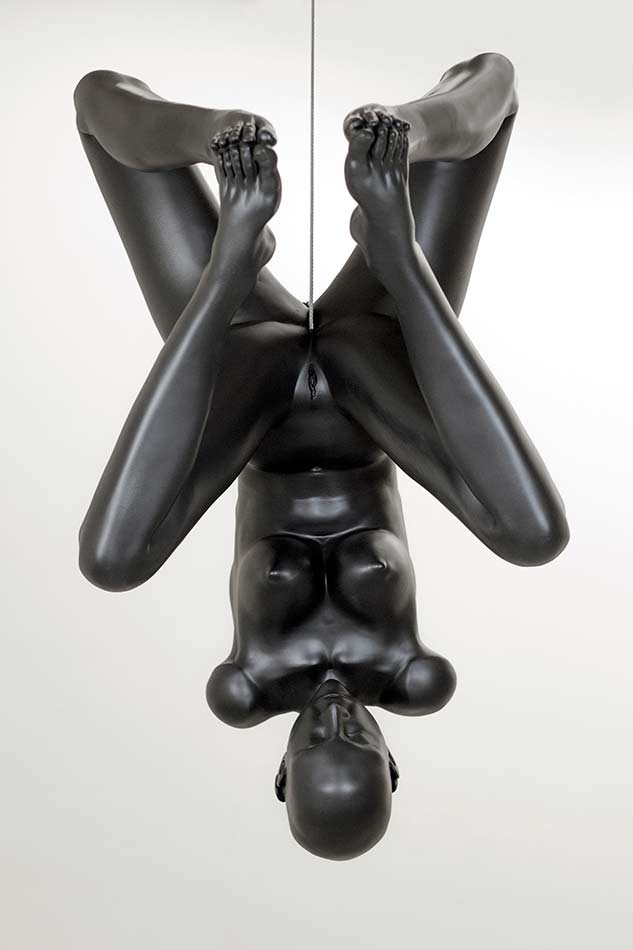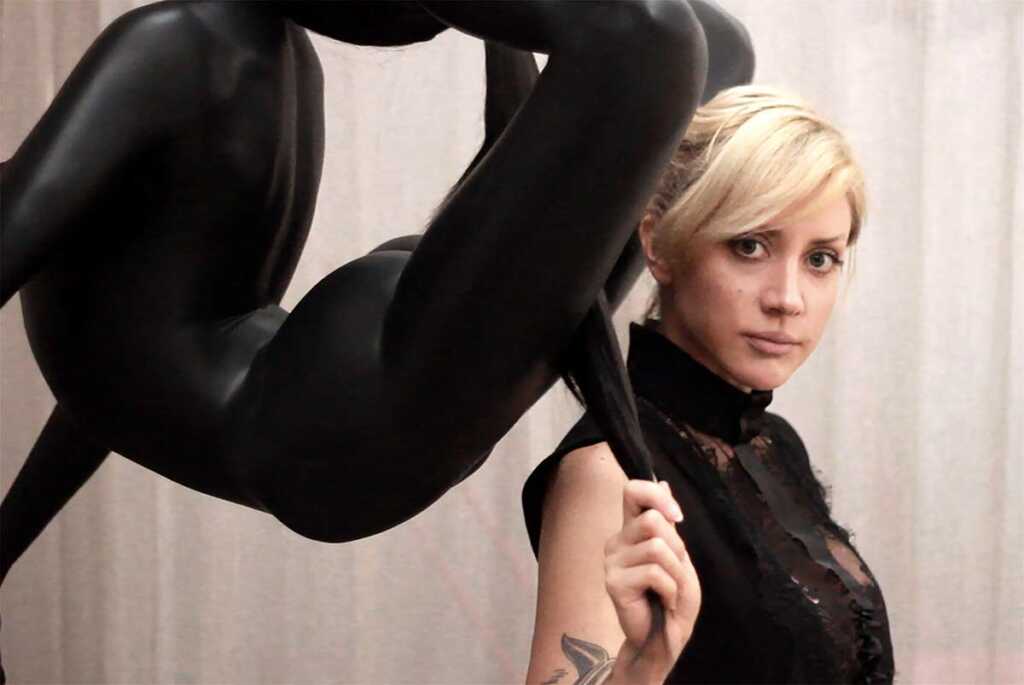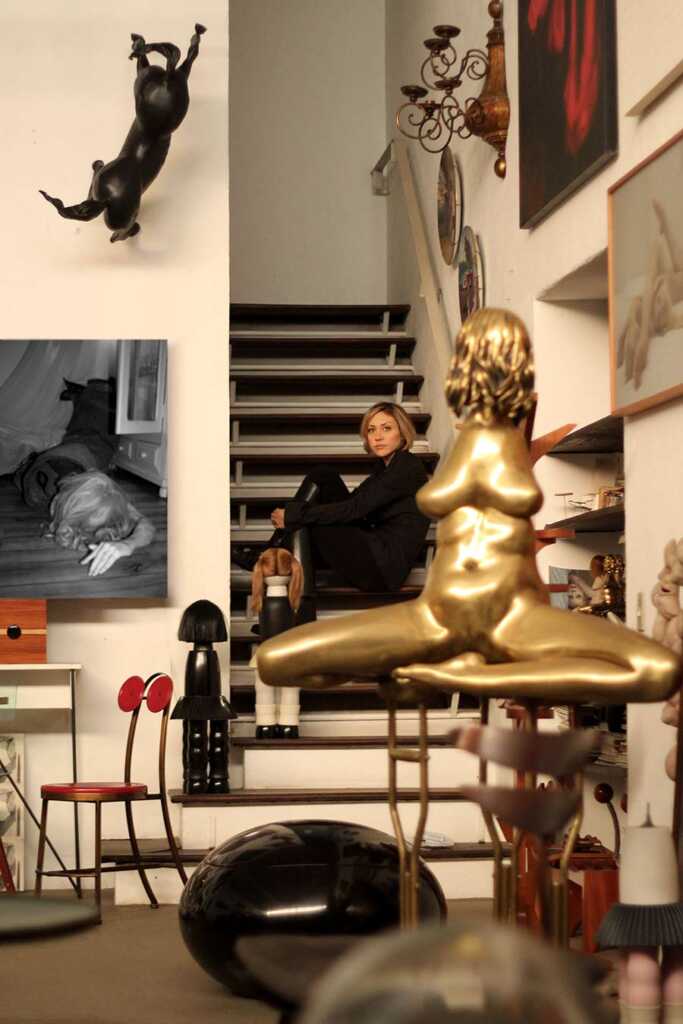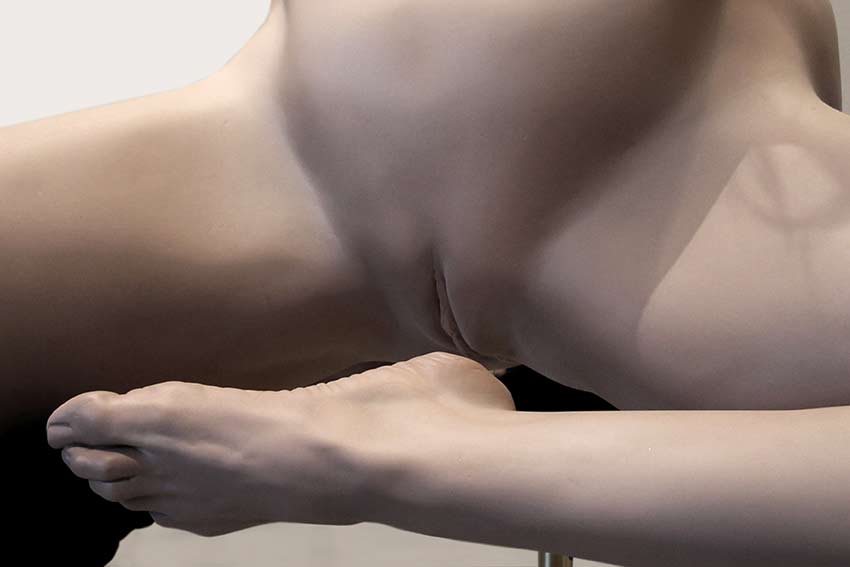
Bronze. 50 x 67 x 29 in (127x170x74cm). Inhotim Institute.
Monica Piloni © All rights reserved.
MONICA PILONI | “SEXUALITY/REPRESSION”
Brazilian Sculpture and Photographer Monica Piloni (b. 1978) exhibits manipulation of bodies in total disarray for the most part. She is known internationally for her figurative sculptural works that explore issues ranging from “sexuality/repression” and “appearance/alienation.” We are pleased to feature some of her latest sculptures.
The three bronze sculptures support each other with opposing forces that ultimately provide equilibrium to the set.
The hands are in a position inspired by oriental religion/symbolism that in Sanskrit is called ‘Tarjani Mudra or Karana Mudra.’ This is also a hand gesture that we see in Afro-Brasilian religious images and is also similar to what heavy-metal culture uses.
“My artistic production is linked mainly to one or more of the following aspects: the triggering of some type of response, such as disturbing the sense of pleasure or beauty, inducing a state of fear (even if the presentation is some kind of order, pattern or aesthetic harmony); transmitting a sense of novelty and originality; really challenging tasks at the moment in history when it seems that everything has been done.
Anguish is my source of inspiration. My individual relationship with my own body and consciousness of being tied up and stuck to the fibers of meat in steady metabolic action, “the loveliest of the prisons,” a brain connected to a digestive tract that is able to reflect, to believe in, or deny, God, this is my anguish and my rant through art. I feel lucky to be able to turn my anguish into inspiration.
The purpose of art is to expose and discuss human issues/ problems…the media or “style” of the artwork is therefore irrelevant if the artist is honest to their purpose.
fibra de vidro, poliuretano, pla (fiberglass, polyurethane, pla)
113 x 63 x 63 cm 44.5 x 24.8 x 24.8 in
Monica Piloni © All rights reserved.
In my work, I decided to show bodies that can’t be real…they are manipulated and in total disarray for the most part. But the perfect detail of almost-industrial manufacturing shifts the viewers’ perception from the twisted to the beautiful.
This is “my two cents” about our alienated society that is avid for aesthetics and used to rapidly fulfilling its desires and needs, and that ends up treating the world as a big garbage can. I work, almost exclusively in sculpture and, since 2011, also in photography and video. But even in these last two media, my sculpture work is presented because I use it as a character.
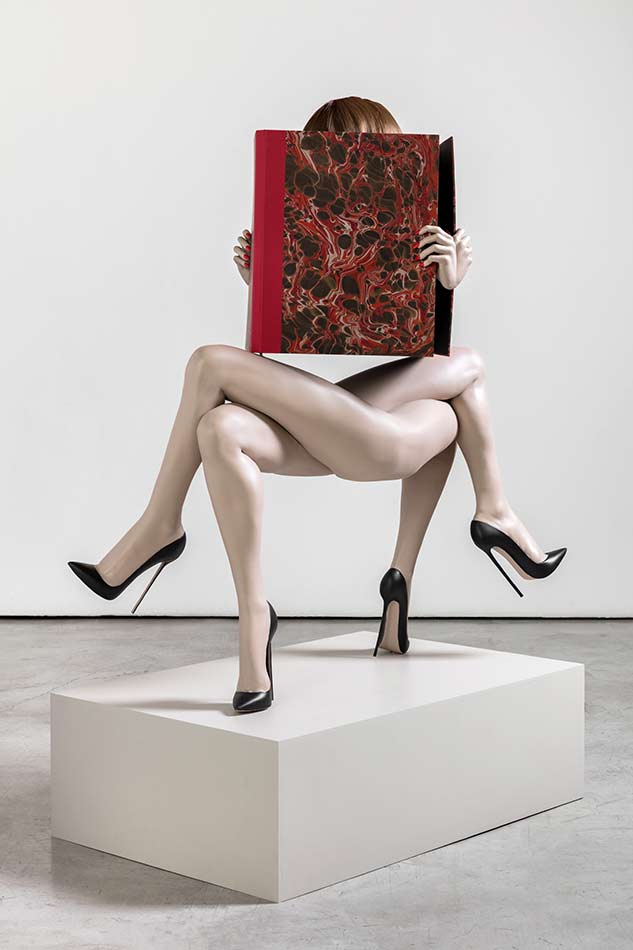
(synthetic hair, fiberglass, pla, books cover) 160 x 100 x 60 cm, 63 x 39 x 23.6 in.
Monica Piloni © All rights reserved.
The main difference between photography and video is that I can direct the viewer’s attention to what I specifically want them to see as the material is bidimensional. This gives me a sensation of power that I had not experienced before. With sculpture, one is exposed to the viewers’ scrutiny from all angles, plus the artwork “shares” the space with whatever backdrop is there, which is out of the artist’s control. I use a large list of materials, some more frequently, such as resin, glass fiber, hair, marble, bronze, and others less so, like leather, wood, and wax. The material itself can sometimes be a source of inspiration. For example, visualizing its possibilities inside the creation, adapting the creation to the material, changing one material for another that allows it to be realized. Or a previous work may inspire a new one; continuing a series of sculptures might interest me anew and make me reflect after nearly a decade. When I think of creating, I refer to a pre-production stage, the drawing stage, the model, the photography as a reference to the three-dimensional. During production, the first step comes from the paper, and it adjusts to the idealized dimension, the construction engineering, the balance, and the chosen material.
70.9 x 37.8 x 37.8 in (180 x 96 x 96 cm) MAC Niterói, Contemporary Art Museum of Niterói, Rio de Janeiro.
Monica Piloni © All rights reserved.
Although my production is empirical, I am not sure what to expect, and I let the accident happen; it is part of the experience about the reflection on the work. A model can serve as a rough sketch, but the resulting sculpture may not look anything like it. The final three-dimensional product may also be included in a series of staged photographs, or in my art videos altered, with some kind of editing or visual effects.
Through the years, the most valuable lesson I have learned throughout my career was to belong…
I started thinking that there was no place in the world for weirdos like me…but now I know there is. Through art, I found a purpose that can even be fulfilled while dreaming in my sleep. I also learned to be less self-centered, which seems to be the nature of the artist class.
I had the opportunity to interact with, get to know, be helped by, and help, many wonderful people who have contributed to my idea of what the world is and that transpires in my work.
ABOUT THE ARTWORKS
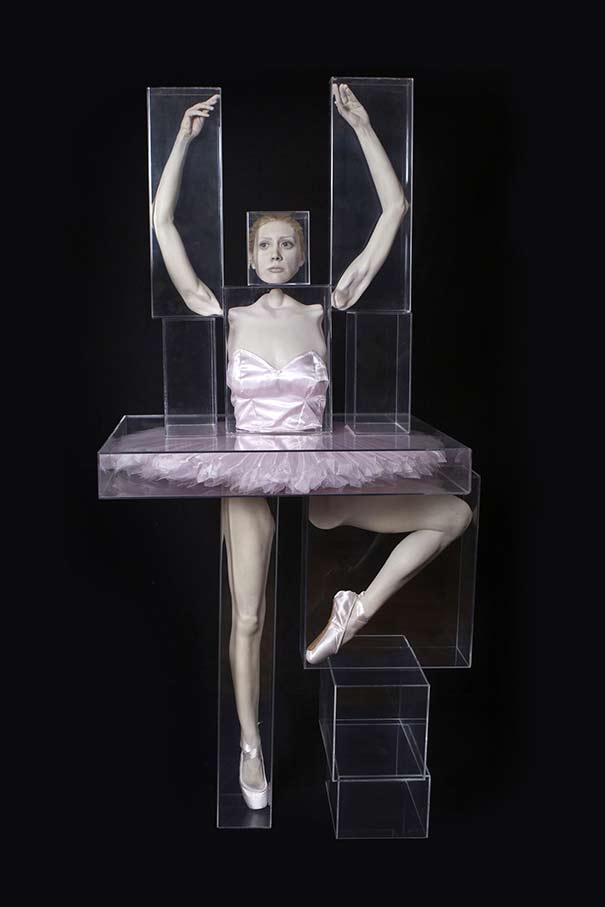
Fibra de vidro, cabelo sintético, próteses oculares, caixas de acrílico (Fiberglass, hair, ocular prosthesis, acrylic)
222 x 95 x 110 cm. 87.4 x 37.4 x 43.3 in Monica Piloni © All rights reserved.
In a Degas exhibition, viewers could see the “Little Fourteen-Year-Old Dancer” through a window display amid the glass reflections. It is evident and inevitable that such a cold physical barrier, designed not to be seen, is absorbed by the nervous system imposing a distance between the viewer and the object.
In this artwork, the absurdly feminine icon of an idealized ballerina was cut into pieces, member by member, with each body part confined in smaller acrylic displays. These displays are transparent pliable boxes that provide order and meaning to the anatomy in pieces.
They are also sufficiently visible to create subtle vertical and horizontal ruptures between the thin acrylic frames that involve, protect, and impose distance-enhancing the strained-muscle content to the untouchable status. The traditional image of the Ballerina carries an emotional and dramatic character, even though it has been unwearyingly consumed and explored, making them almost unreal beings from an idealization of immateriality. In this real-size sculpture, the Ballerina is represented using a hyper-realistic treatment. The anatomic dismembering stresses the dramatic aura. The body pieces could be lifeless and spread on the floor, but they were given a fake and artificial life essence.
The sculpture consists of seven acrylic boxes that perfectly fit the dimensions of each part of the body and four empty boxes that serve to support other boxes.
It is possible to move the boxes individually and change the position of the body of the Ballerina.

